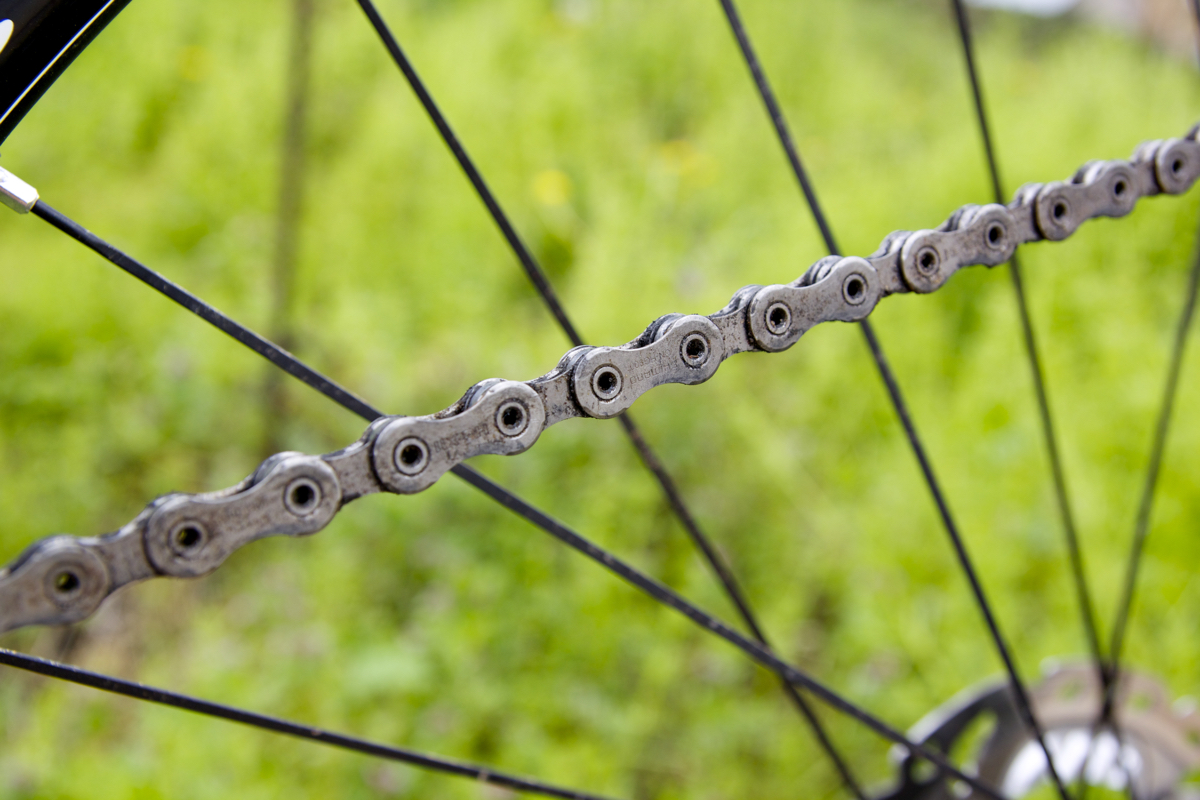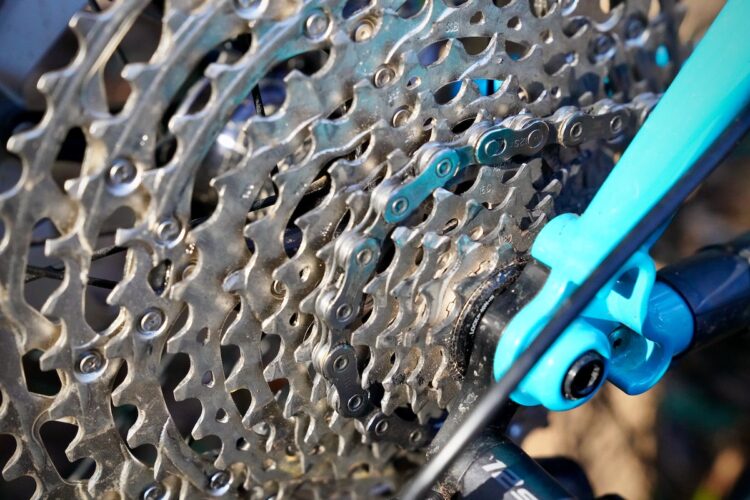
Shimano has been making big changes to their drivetrain lineup over the last year or so, introducing electronic shifting and an all-new 11-speed drivetrain. I’ve been testing the company’s mechanical XTR Race setup over the last couple of months as a part of my review of the Motobecane Fly Team 29 Ti, and while there’s a lot going on here, I’ll do my best to hit the most interesting bits I’ve found.
Cassette

One of the best things about the new 11-speed cassette from Shimano is that it’s compatible with existing, standard hub driver bodies. While this means the gear range is limited on the low end to 11t (XX1, with its XD Driver allows you to run a 10t), Shimano offers compatible 2- and even 3-ring cranksets for an extended gear range (more on that in a bit.)
The XTR 11-speed cassette shifts very smoothly thanks in part to something Shimano calls “Rhythm Step progression.” Looking at the cassette, you can see each tooth has been computer modeled and precisely machined to produce crisp, smooth shifts every time. The cassette looks a little clunky and isn’t as lightweight as SRAM’s 11-speed cassette, but it’s still a huge upgrade over existing Shimano models. On the high end you get a 40t cog which is welcome for those running a single chainring up front.
Cranks

I mentioned the cranks come in 1, 2, and 3 chainring configurations, and the drivetrain I’ve been testing features the 2-ring “Race” version. Shimano is offering the XTR cranksets in Race and Trail versions with the Race version coming in slightly lighter and with a narrower Q-factor. The Race version is only offered in single and double chainring configurations; if you want three chainrings you’ll need to go for the Trail version.
The cranks have a real space-age look and although they’re not carbon (only the shift ramps on the two-ring version are carbon), the claimed weights are a few grams lighter than XX1. For example: the single ring Shimano Race crankset has a claimed weight of 563 grams (not including a bottom bracket; this adds another 63g.) SRAM’s XX1 (with bottom bracket) weighs 645g, making the Shimano 19 grams lighter. Curiously, Shimano decided to utilize a unique bolt system on the two-ring crank I’ve been testing, which certainly gives the crankset an interesting look–but also probably adds to its weight. The shiny finish scratches easily, especially if you rub the inside of your shoe on the crank arms like I do.

The teeth on the outer chainring of each XTR crankset feature titanium teeth for added durability. This should reduce wear while adding strength against rock and root strikes. (Of course, that’s less of an issue when you’re riding a single chainring.) Shimano also utilizes a narrow-wide design for improved chain retention.
Shifters and Derailleurs
Starting at the rear of the bike, the new XTR rear derailleur features a clutch mechanism which minimizes chain slap and keeps the chain in maximum contact with the cogs for improved reliability. Shimano’s clutch can be turned on or off, though it doesn’t “lock” into place like SRAM’s does for wheel changes.

The front derailleur sports super-smooth cable routing for improved shifting performance. Mine has remained dialed the entire time and hasn’t rubbed in any cross-chain situations.

The shifter levers feature different textures on the up and down shift levers: the forward lever is shiny with a dimpled texture while the back lever is matte with vertical ridges. Even with gloves on it’s easy to distinguish between the two. The shifters even allow the rider to smoothly shift to one or two more difficult gears at a time. In the video below, the first two shifts are normal shifts; the next four shifts are “doubles.”
On the trail
At this point in my review I feel like the only thing left to talk about is what the Shimano XTR 11-speed drivetrain doesn’t do. We all know how a drivetrain works on the trail and as cliché as this may sound, we expect our drivetrains to just work every time.

After 100+ miles of riding, the drivetrain never dropped a chain and the front derailleur didn’t drag, even under cross-chaining. It never skipped a gear on a shift and didn’t need any adjustments (by the way, I hate derailleur adjustments).

My only complaint has nothing to do with performance but here it is anyway: shifting is loud. This isn’t the first time I’ve had this observation about a Shimano drivetrain and in a way, I’ve come to expect it. Shimano shifts are authoritative and I almost think it’s by design, sorta like the way Harley Davidson tunes their motorcycles to produce that signature muffler sound. You know it’s a Shimano drivetrain because it feels strong and decisive, even in the shifts.
Single chainring drivetrains aren’t for everyone, and Shimano has done a great job at making the new XTR drivetrain adaptable and accessible to all types of riders. The entire group has all the quality mountain bikers have come to expect from the XTR name and should be a worthy upgrade for riders looking for an edge.
MSRPs, according to JensonUSA:
- Rear Derailleur: $239.99
- Front Derailleur: $119.99
-
2x Crankset: $599.99
-
Cassette: $349.99
-
Shifters: $119.99 per shifter
- Chain: $?
- Total: $1,429.95+



















